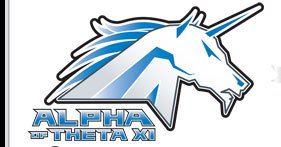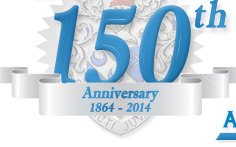Allen B. DuMont A349: ‘The Father of Television'
In January of 1951 --a past issue of the Alphabet tells us-- an addition to the chapterhouse's living room made its first appearance. What was it? Why, it was a television set donated by Brother Allen B. DuMont A349, Class of 1924. Concerns over the effect that the television would have on school grades led to the ‘control' of the television set being turned over to the chapter's scholarship committee. What was so special about this TV? The television set was a ‘DuMont', manufactured by Brother DuMont's own company and on it you could watch stars such as Jackie Gleason perform on the DuMont Television Network.
Did making television sets and having his own television network give Brother DuMont a claim to the title, \"Father of Television\"? Not directly. Men such as Philo T. Farnsworth and Vladimir Zworykin among others share the spotlight in the development of television as we know it but DuMont helped bring the television set into the commercial mainstream by making its basic component affordable and practical and thus, along with other reasons, deserving of that title.
Of course, these days we can watch sitcoms, sports and movies in high definition on flat screen televisions using the now commonplace liquid crystal display (LCD), plasma display panel (PDP) and digital light processing (DLP) technologies. Before the advent of these, though, almost everyone relied on the cathode ray tube (CRT) to display a television picture which is where our very own Brother DuMont made his place in history. He developed the first practical long-lasting CRT for use in televisions and was the first to market with home television sets in 1938. Before his invention, CRTs lasted only 25-30 hours before burning out and had to be imported from Germany at high cost.
Born on January 29, 1901, Allen Balcom DuMont spent his early years in Brooklyn, New York, before eventually moving with his family to Montclair, New Jersey, when he was 13 years old. While living in Brooklyn, he spent the better part of a year in bed because of polio at age 11. His father, the secretary and treasurer of the Waterbury Clock Company, bought him a crystal radio set while he recuperated. This was the beginning of a long affair with radio transmitting and receiving equipment and it led to his working as a ship's radio operator for many summers while in high school and in college.
Though it happened in an indirect fashion, we can thank Brother Palmer C. Ricketts A84, then president of the Institute, for bringing DuMont to RPI; at the time, President Ricketts was wont to market the school by sending out news bulletins describing the engineering feats that its graduates had gone on to do later in life. It was one such publication that included pictures of the Brooklyn Bridge and other engineering works which brought the Institute to Brother DuMont's attention and he ended up starting college at Troy after graduating from Montclair High School in 1919.
Pursuing a degree in electrical engineering, DuMont became associated with the brothers of Theta Xi and, along with his younger brother, Donald H. DuMont A353, was initiated into the Bonds on October 24th, 1920. While at school, his fondness for swimming later led him being referred to as the \"human fish.\" His time spent in the lab, though, working with the oscillographs to study waveforms was where he began to formulate his ideas of using CRT technology to improve these electronic instruments as well as other devices. Unfortunately, while at RPI, one of the summer ship voyages he signed up for as a radio operator did not return him to America until late December, and this delay forced him to spend an extra year in college to make up the missed time. After graduating from RPI in 1924, Brother DuMont married his fiancee Ethel two years later and they had two children, Allen Junior and Yvonne. For his first job, he spent 4 years working for the Westinghouse Lamp Company followed by a 3 year stint at the De Forest Radio Company before the company failed and he was out of work.
In similar fashion to other noted beginnings in the history of famed business ventures, Brother DuMont decided to start his own company in the basement of his home though he had only $500 to his name and an equal amount from his neighbor. His goal was to develop a long-lasting CRT for use in electronics and success was soon at hand. From this humble beginning in 1931 arose the Allen B. DuMont Laboratories which at one time was the only commercial manufacturer of CRTs in the country. Television at the time was still in its infancy but money was to be made making CRTs and marrying them to oscillographs. Today, we would refer to these devices as oscilloscopes and RPI was among the company's first customers.
Not so well known at the time, but what was to become vitally important to the national defense, was Brother DuMont's contribution to the development of radar. He withdrew his 1933 patent application for a radio locator using radar at the request of the War Department (predecessor to the Department of Defense) which cited \"the military nature of the disclosures.\" (He tried again in 1939 to patent his work, but a French patent filed two years earlier force him to give up the matter.) When the country geared up for the war effort during the 1940s, DuMont's manufacturing plants supplied CRTs and equipment to the government. In essence, his work developing CRTs had also made radar practical and he was able to develop long-range precision radar for use during the war.
Most will remember the DuMont name, though, for the television sets and the network that bore his name. His company's initial success at making and selling CRTs allowed DuMont to expand into television manufacturing and led to the licensing of several television stations to form the DuMont Television Network. In the process, he became the industry's first millionaire going from first-year sales of 70 dollars to sales in 1951 of 75 million dollars.
Brother DuMont's success earned him many accolades but he did not forget his brothers in Theta Xi. He attended a dinner in December 1947 held by the NYC Theta Xi Alumni Club to honor Brother Edward P. Hamilton A206 and celebrate Alpha's winning the Memorial Trophy for 1946-1947. As he worked to help create new government standards for television, DuMont spoke at the 87th Anniversary Convention in 1951 on the subject of the government's concern over television. He also showed his generosity to Alpha by donating a television set to the chapter as noted previously perhaps in celebration that his son Allen, Jr., who also attended RPI had just been initiated into the Bonds as A781 the previous spring.
While the DuMont Television Network no longer broadcasts and no new televisions bear his name, the DuMont name lives on at RPI and at Alpha Chapter. After his death in 1965, the Allen B. DuMont Foundation established a prize to be awarded to \"a graduate student in electric power or electrical and systems engineering who has demonstrated high scholastic ability and has made a substantial contribution to that field.\" A room in the Student Union has been named for him. When it came time to enshrine the inaugural class of the RPI Alumni Hall of Fame in 1998, Brother DuMont joined fellow Alphas Palmer C. Ricketts A84 and Emil H. Praeger A272 in being inducted that year.
|






